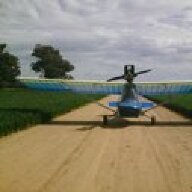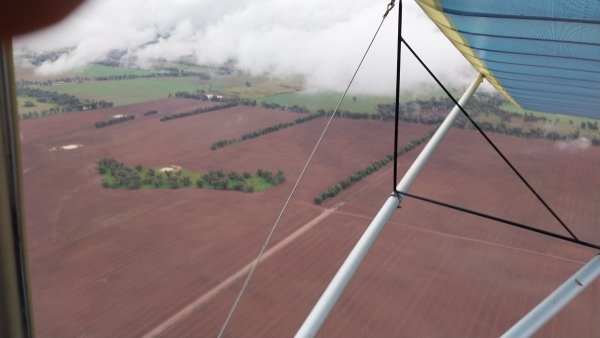-
Posts
3,045 -
Joined
-
Last visited
-
Days Won
64
Content Type
Profiles
Forums
Gallery
Downloads
Blogs
Events
Store
Aircraft
Resources
Tutorials
Articles
Classifieds
Movies
Books
Community Map
Quizzes
Posts posted by Thruster88
-
-
These guys have a turbocharged 2stroke.
https://www.rotax.com/en/products/rotax-powertrains/details/rotax-850-e-tec-turbo.html
-
 1
1
-
-
2 hours ago, skippydiesel said:
I wonder why both turbo & super charged?
Surly one or the other (particularly super charger) would achieve the desired pressures
My guess is the air doesn't go into the crank case like a regular 2 stroke so it needs an external air pump at all times. Super charged for starting, turbo for altitude performance.
Super chargers sap horsepower so that needs to be kept to the minimum required.
-
 1
1
-
 1
1
-
 1
1
-
-
I really like 2 stroke engines. It might be a turn off for some potential buyers.
-
Mooney's are fast for their 180 or 200hp engines. An RV with the same engine is significantly faster, back seat, who needs that. Lancair 360 with 180hp even faster. The fixed gear RV is hard to beat. Van's total performance.
-
3 hours ago, skippydiesel said:
So Nev - I have three fuel tanks (one of which has no external fueling point) how would you access and monitor the levels, in flight?
Beavers have three tanks in the floor. The selector has only four positions, front, centre, rear and off. Such a fuel selector would be perfect for your three tank aircraft.
No external filler on one tank? Why?
-
The gear warning must not have been working or was incorrectly adjusted.
-
 2
2
-
-
6 hours ago, skippydiesel said:
Currently all TO/Landings must be on one/both 30L Wing tanks, because the Boost pump only feeds from them.
I am also considering a bypass line (with one way valve) around the Boost pump as per Rotax recommended best practise.
If I understand correctly your current fuel selector allows the option of selecting both wing tanks. This is not acceptable in a low wing aircraft. It only works correctly in high wing (cessna) aircraft.
In a low wing aircraft air will enter the system from an empty tank regardless of the other tanks contents if both was selected. Piper, Beech, Van's RV aircraft never have the both option, only left or right or off.
-
Bit of a long video Skippy, perhaps you could summarise. I did see the bit when the engine was running rough over the mountain, no mention of fuel pressure or auxiliary pump operation which seemed a bit strange to me.
-
Yes, all good thanks
-
This page is now smaller, the what's new page is now to large for the screen on a Samsung s3 in landscape.
-
Farming, Fishing and Mining are eligible to claim back the fuel excise. Seems reasonable since that tax is supposed to be only used for roadworks. Avgas and Jet-A have a very low excise.
 Excise duty rates for fuel and petroleum products
WWW.ATO.GOV.AU
Excise duty rates for fuel and petroleum products
WWW.ATO.GOV.AU
Fuel and petroleum products and the excise duty rates that apply to them.-
 1
1
-
 1
1
-
-
I see the aussie Sling agent has registered the first sling tsi high wing in Australia and it has a 916 engine. Similar or better performance and useful load as the current model C182.
-
 1
1
-
-
Not as close as this. It did fly away.
-
The biggest competitor to the 170D are the low hour, always hangared, as new used 170's. There is one for sale now, about 400 hours for $70k. Hard to compete with that.
-
I am not sure how you have advertised the event, nothing has come up on my Facebook feed. A Facebook search reveals one post from the mountain veiw motel, not many people would follow them. I only know the event is on from this forum. I have a prior commitment that weekend.
-
 1
1
-
 1
1
-
-
4 minutes ago, BrendAn said:
i have driven an 892 powered roadtrain one harvest. 445hp and no torque. i loved it even though it crawled up the hills. i am not saying they are any good, just that i like them.
That would have been a 8v92T, the T means it was turbocharged into the gear driven super charger. Interestingly the tsi has returned 20-30 years later in some VW and other small capacity, 1.4l engines. There is nothing new.
-
 2
2
-
 1
1
-
-
On 30/04/2023 at 6:12 PM, BrendAn said:
I have played with engines all my life too but I am open to new designs . One of them will succeed eventually.
I have a vf ss and have owned gt Falcons among others. But my favourite exhaust note is by far a 2 stroke GM diesel. I fitted a 453 turbo in one of my boats and it sounded fantastic. All the old blokes would stop and listen to it .
Humans are intelligent and ingenious, all the possible internal combustion configurations have been thought of. The 4 stroke piston engine will not be dethroned by any other ic engine.
We had a GM 8v71 at the old farm, just because it was a cheap option to re power an old earth mover. Ultimately the market removed that engine from use in new equipment.
-
 1
1
-
-
No they are single flare. There is a backing part that is inside the nut. The nut should turn on that piece so the pipe flare is just being clamped.
-
 1
1
-
 1
1
-
-
8 hours ago, facthunter said:
I can't see that flared al pipe is safe, especially with the normal type nut, Flaring thins the metal a lot and there's a sharp bend formed where it commences.. You also have the problem of lining it up accurately and accessing it to undo it You need something to hold the TEE too. Nev
Every Cessna, Piper and Beechcraft has it in their fuel system. There is also one aluminium flared pipe attached to each cylinder head on every Lycoming engines as the oil return line, doesn't get much harsher in terms of vibration. They have been doing this for at least 60 years now.
-
 1
1
-
 2
2
-
-
1 hour ago, BrendAn said:
i made a few calls today. 1st to raaus where i was given the name and number of their broker. geoff the broker was very helpful we went through what is covered by our raaus policy which is liability only as we knew anyway. pilots family receives nothing but passenger is covered to 250 k. geoff has recommended agile insurance, they have a death only policy for fixed wing aircraft only which means the gyro will have to go. the agile policy for 250k is 1200 a year.
i still have to go through my life insurance policy to see if they actually put the flying exclusion in the original pds.
250k over 1200 = 1 in 208 before insurance co profit. Is your chance of death while flying really that high per year? My rough analysis suggests it is closer to 1 in 2000 (for active RAAus pilots), still alarmingly high.
If you have aviation disease, and it seems like you might, you will not give up flying. Can't get insurance so what to do. The only way forward is to manage your own risk. I have studied light GA aircraft accidents long before I learned to fly 38 years ago age 21. If you avoid the big three, stalling in any phase of flight including after engine failure, VFR in to IMC, ie flying in cloud while not rated for it and low level beat up you will improve your risk of not dying in an aircraft accident to very near 100%. Treat each flight as a mission and plan accordingly. Think what is going to happen in the next five minutes of this flight as you fly.
-
 1
1
-
 1
1
-
 1
1
-
-
From the news video and incident report it sounds like a messed up go round, aerodynamic stall, wing drop, cart wheel.
Stalling, from any height, is and always has been the number one way light aircraft crash. How do we fix this? Airline pilots never stall their aircraft, should us simple flyers try to emulate them? No disrespect is intended to any pilot.
-
 1
1
-
 2
2
-
-
If you have a rough diagram of what are need i am sure Rodney or any other LAME would help you. They may even have all the fittings in their store.
I am curious why you need to modify the fuel system, is it in accordance with the sonex build manual? Have you obtained advice on any modification
None of the fittings (nipples, elbows or crosses) come with nuts because they are usually part of hose assembly.
-
I think Skippy used the term "calibrated airspeed" to mean the box connected to the aircraft pitot tube was calibrated, not CAS you find in a POH.
-
 1
1
-
-





Jet-A fuelled 180HP piston-engine type-certified
in AUS/NZ General Discussion
Posted
Interesting that the super connie had power recovery turbines helping drive the crankshaft.
In 1953, R-3350 Turbo-compounds were made available for civil use. Lockheed incorporated them into the L-1049C, which first flew on February 17 of that year. The R-3350-972-TC18DA-1 turbo-compound engines on the L-1049C had a new turbine system, the Power Recovery Turbines (PRT). Each engine's exhaust gas flowed through three turbines, increasing power by 550 hp (410 kW).